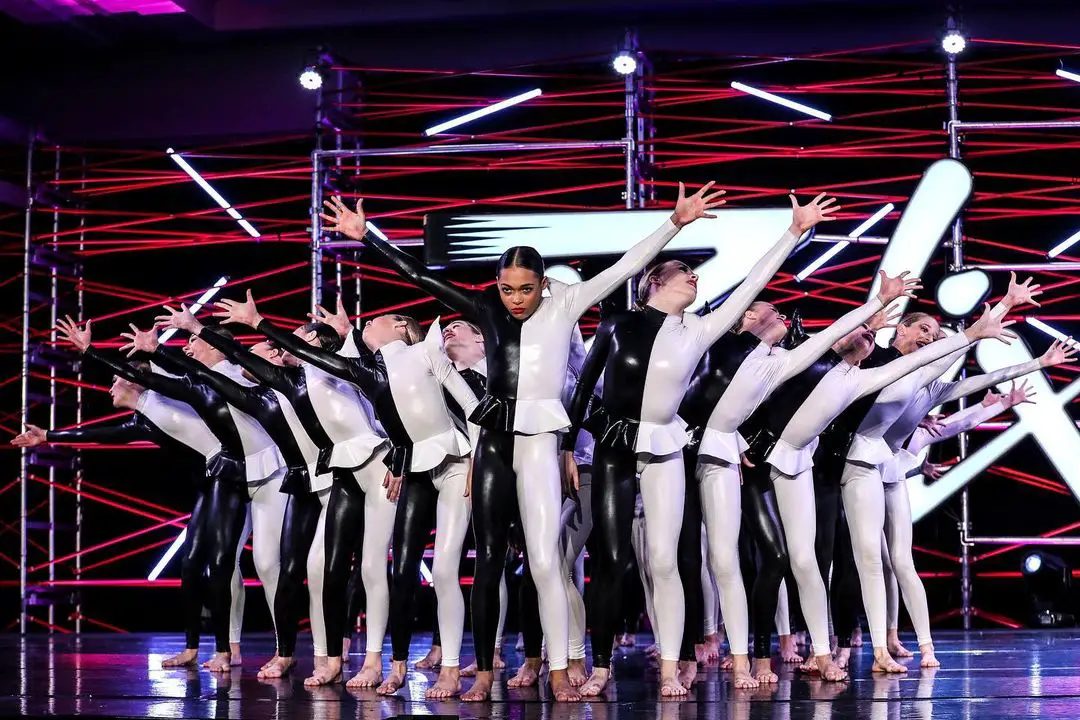Football fans watch the Super Bowl, basketball fans watch March Madness, baseball fans watch the World Series — and dancers watch nationals. These week-long events have been and will continue to be both training grounds and launchpads for young dancers’ careers. Nationals are the culmination of a dance convention’s touring season; they spend the year touring and bringing the most popular and experienced dance teachers to cities across the country, then bring the best dancers together to compete at nationals.
The first aspect of nationals is what conventions do every weekend: The star-studded faculty teaches full days of dance classes in rooms divided by age. Not only are these classes fun learning opportunities, but they also have benefits beyond the dance training they offer. First, since dancers from each studio are combined into one hotel ballroom, dancers from all over the country dance with each other and form relationships.
In fact, many dancers cite conventions as where they met their closest friends. Second, nationals bring famous faculties to students that otherwise wouldn’t get to learn from them. After all, smaller studios rarely attract the popular teachers that conventions provide.
The second aspect of nationals is the highly anticipated finals competition, where the best studios and routines from throughout the convention’s season duke it out on stage. Performances are divided by style; each routine competes against others in categories like hip-hop, jazz, contemporary and ballet. Finals competitions also involve awarding national titles to the winning male and female dancer in each age group. While age cutoffs vary between conventions, minis are usually 8-10, juniors are 11-12, teens are 13-15 and seniors are 16-19.
To compete for a national title, dancers must qualify at a regional competition. Then, at nationals, they participate in an intense selection process including a solo performance, a formal audition, an on-stage improvisation and finally recompeting their solo. Though it is a difficult process, the benefits of winning — or even placing in the top 10 performers — are great. Not only are winners provided with scholarships to the following year’s regional and national events, but they also gain recognizability in the dance community, close connections to the incredible faculty and opportunities to perform and assist the convention staff.
These opportunities contribute to the popularity of nationals among dance fans because they want to see who will be on their Instagram and YouTube feeds performing in convention videos. Viewers are also interested in seeing who wins in the long run because of the notability of past winners. Past national title winners include “So You Think You Can Dance” winner Lex Ishimoto, Guinness World Record holder Sophia Lucia and singer Tate McCrae. Dancers and dance fans want to know who to keep an eye out for in the future.
Viewers also have attachments to dance studios, much like sports fans have attachments to teams. These allegiances emerge in many ways, mainly from TV and social media. Many studios have competed on competition shows like “World of Dance” and “America’s Got Talent,” and many individual dancers have appeared on shows in the “Dance Moms” universe. If viewers see and enjoy a performance, they want to see those dancers win at nationals. Loyalties also emerge from social media; as studios post performance videos, viewers become invested in the studio want them to do well.
Radix
The newest convention to rocket to popularity is Radix, an event that focuses on “outstanding training in both fundamental dance techniques and today’s most cutting-edge styles.” These goals are embodied by the faculty; Radix teachers are the most sought-after and creative choreographers in the dance community today. Among them, they have choreographed for Britney Spears, Taylor Swift and Beyoncé, they have multiple Emmy and VMA award nominations and wins, and they have even performed with Cirque du Soleil, Madonna and countless other big names.
Radix’s focus on innovation continues in their judging. At their nationals, they award “Best in Show” to the best routine at the event as well as smaller awards to the best in each age category. This year, these categories were dominated by the groundbreaking performances of Impact Dance Studio. Their junior piece, “Derniere Danse,” featured creative choreography and the use of rolling benches as props.
Impact also won “Best in Show” with their teen piece, “New York, New York,” in which they took a more modern interpretation of the classic song, which contrasts with more jazz-centric performances. In both of these incredible pieces, Impact did the unexpected given the songs they used, just as many of the Radix faculty members do.
Radix’s national title, called Core Performers, was a close competition this year; any of the junior female finalists could have won the title. Aaliyah Dixon from Summit Dance Shoppe highlighted strength and acrobatic work in her solo by contemporary choreographer Zoï Tatopoulos. While Tatopoulos’ choreography seems odd at first glance, it is widely acknowledged as some of the most physically challenging in the dance community today.
Also competing for the junior female Core Performer title was Gracyn French, who is also known for her technique and comes from the jazz powerhouse studio Project 21. The performance quality in her solo never fails to entertain the audience and places her above her peers. In the end, however, Crystal Huang from the Rock Center for Dance took home the title. She has won many national titles and has become known for her precise technique and strong ballet training, which is clearly evident even in this year’s more stylized solo.
The Dance Awards
The Dance Awards are the combined venture of conventions Nuvo, 24 Seven and Jump, all of which are run by the production company Break the Floor. The event began in 2011 and pioneered the nationals format that many conventions now follow. The faculty of these events, since it is made up of the faculty of three conventions, is large, talented and diverse. The Dance Awards offer classes that range from ballroom with “Dancing with the Stars” pros Jenna Johnson and Val Chmerkovskiy, to contemporary with Emmy award winner Travis Wall, to jazz with former Disney Channel performer and choreographer Will Loftis.
After The Dance Awards’ format proved popular, the event was split into two locations: New York and Las Vegas. The New York event was later moved to Orlando in 2016. This move affected the competition itself; because of its proximity to Miami, a hub of ballroom dance, the Orlando event has had some of the most serious competition between ballroom teams. The 2021 event was no different.
The competition was particularly fierce in the teen group division between Miami studios Stars Dance Company and Dance Town, and the Utah hub of ballroom dance, Center Stage Performing Arts Center. Stars performed “After Hours,” a technical and precise Latin piece. Dance Town took a more classical approach, performing “Salsa” in the traditional style. Center Stage focused more on performance quality and audience entertainment in “Diamonds,” pulling moves and technique from multiple ballroom styles. The routines were so difficult and polished that they would not look out of place on an episode of “Dancing with the Stars.”
The Dance Awards’ other categories in Orlando and Vegas also weren’t a disappointment. Compared to Radix, The Dance Awards tend to reward more classic choreography and technical performances. In Orlando, they awarded the Best Choreography Award to Molly Long’s junior jazz piece, “Stuff Like That There.” While Long’s choreography is unique, it features more traditional jazz techniques like long body lines, ballet technique and stylized moments. While this routine also placed well at Radix, it embodies what The Dance Awards value more.
The most notable win in The Dance Awards Las Vegas Best Dancer title competition was in the junior female division. After the intense competition, Crystal Huang won her second title of the summer. Double titling as she did is rare for dancers to do, but it is the second time Huang has achieved this goal. In 2019, she won both Radix Mini Core Performer and Mini Best Dancer. Another noteworthy win was Ella Horan winning the Senior Female Best Dancer award because she continued the tradition of Westside Dance Project performers winning this category. Alyssa Allen won in 2014, Lucy Vallely won in 2018 and now Horan holds the coveted title.
At any nationals event, the most thrilling title competition is between the senior males. These dancers have both the training and strength to perform incredible technical skills and the creative maturity to clearly portray developed stories on stage. In the competition between the top three at The Dance Awards Orlando, Thiago Pacheco and Carter Williams showed this beautifully, but title winner Jaxon Willard’s performance was particularly powerful. He begins with simple movements performed with strong intention. A minute into the solo, however, Willard pulls out his trademark technical skills that are near impossible for anyone else.
Conclusion
The value of these events cannot be overstated. Between the great training the classes offer, the challenging and healthy competition and the visibility awarded to title winners, national competitions provide experiences beneficial for dancers whether they intend to continue dancing or not.

















